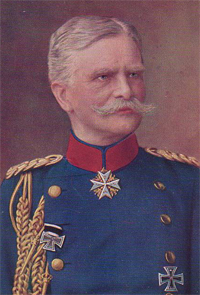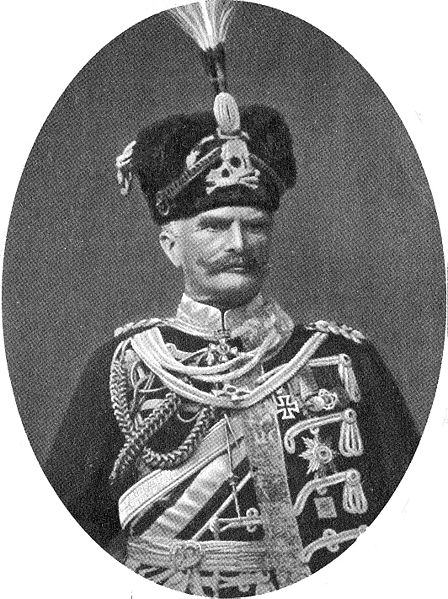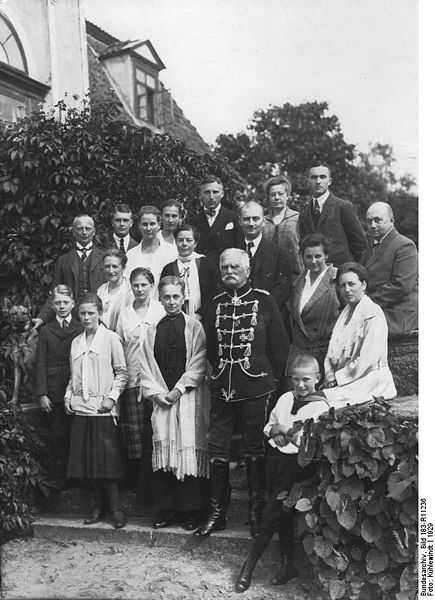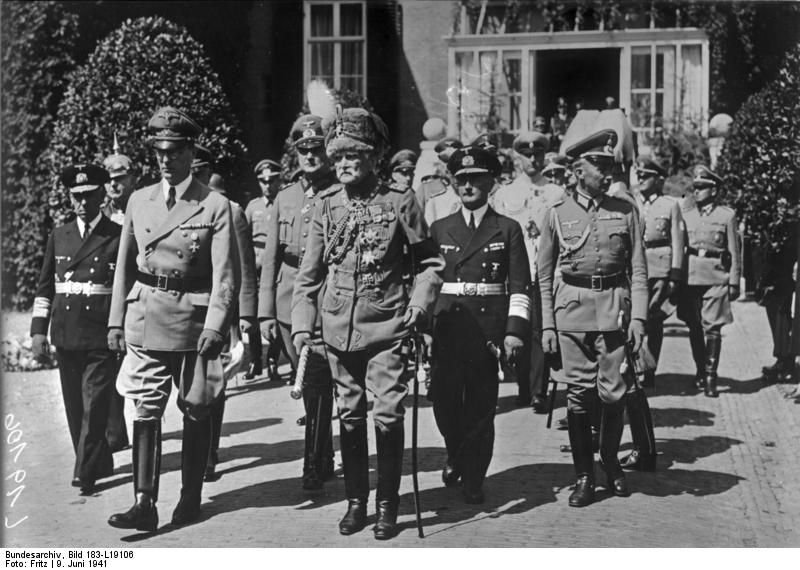<Back to Index>
- Physicist Yoshio Nishina, 1890
- Painter Jean Frédéric Bazille, 1841
- Field Marshal Anton Ludwig August von Mackensen, 1849
PAGE SPONSOR


Anton Ludwig August von Mackensen (6 December 1849 – 8 November 1945), born August Mackensen, was a German soldier and field marshal. He commanded with success during the First World War and became one of the German Empire's most prominent military leaders.
Mackensen was born in Haus Leipnitz, near the village of Dahlenberg in the Prussian Province of Saxony, to Louis and Marie Louise Mackensen. His father, an administrator of agricultural enterprises, sent him to a Realgymnasium in Hallein 1865, with the apparent hope that Mackensen would follow him in his profession.
Mackensen began his military service in
1869 as a volunteer with the Prussian 2nd Life Hussar Regiment (Leib-Husaren-Regiment Nr. 2). During the Franco
- Prussian War he was promoted to second lieutenant and
recommended for the Iron
Cross, Second Class. He left
service and studied at the Halle
University, but formally
returned to the German
Army in 1873, with his old regiment.
In 1891 he joined the General Staff in Berlin, where he was heavily influenced by the new chief, Alfred von Schlieffen. From 17 June 1893 to 27 January 1898, Mackensen commanded the 1st Life Hussar Regiment (Leib-Husaren-Regiment Nr. 1), to which he became à la suite when he left command and whose uniform he often wore as a general. He was ennobled on 27 January 1899, becoming August von Mackensen. From 1901 to 1903, he commanded the Life Hussar Brigade (Leib-Husaren-Brigade), and from 1903 to 1908 he commanded the 36th Division in Danzig. When Schlieffen retired in 1906 Mackensen was regarded by some as a possible successor, but the job went to Helmuth von Moltke the Younger. In 1908, Mackensen took command of the XVII Army Corps, and commanded this corps until shortly after the beginning of World War I.
At the beginning of World War I Mackensen remained in command of XVII Army Corps as part of the Eighth Army under first General Maximilian von Prittwitz and then General Paul von Hindenburg and saw action in the battles of Gumbinnen and Tannenberg. On 2 November 1914 Mackensen took command of the Ninth Army from General von Hindenburg, who had been named Supreme Commander East (Oberbefehlshaber Ost). On 27 November 1914 Mackensen was awarded the Pour le Mérite, Prussia's highest military order, for actions around Łódź and Warsaw. He commanded the Ninth Army until April 1915, when he took command of the Eleventh Army and Army Group Kiev (Heeresgruppe Kiew), seeing action in Galicia, and assisting in the capture of Przemyśl and Lemberg. He was awarded oak leaves to the Pour le Mérite on 3 June 1915 and promoted to field marshal on 22 June. After this campaign, he was awarded the Order of the Black Eagle, Prussia's highest ranking order of knighthood. During this period, he also received numerous honours from other German states and Germany's allies, including the Grand Cross of the Military Max Joseph Order, the highest military honour of the Kingdom of Bavaria, on 4 June 1915.
In
October 1915, Mackensen, in command of the newly-formed Army Group
Mackensen (Heeresgruppe Mackensen, which included the German
11th army, Austro - Hungarian 3rd army, and Bulgarian 1st army), led a
renewed German - Austro -
Hungarian - Bulgarian campaign against Serbia.
The campaign finally crushed effective military resistance in Serbia
but failed to destroy the Serbian army, which, though cut in half,
managed to withdraw to Entente held ports in Albania and, after
recuperation and rearmament by the French, reentered fighting on the Macedonian front.
During the fight for Belgrade,
the troops of the Central Powers encountered a very stiff resistance,
so Mackensen erected a monument to the Serbian soldiers who died
defending Belgrade, saying, "We fought against an army that we
have heard about only in fairy tales". He
followed this up in 1916 with a successful campaign against Romania (under the overall command
of General Erich von
Falkenhayn). He was in command of a multi-national army of Bulgarians, Ottoman Turks,
and
Germans. Despite this, his offensives were very successful,
breaking every army that faced his own. On 9 January 1917, Mackensen
was awarded the Grand Cross of
the Iron Cross, becoming one of only five recipients of this
honour in World War I. From 1917 on, Mackensen was the military
governor of the parts of Romania (mainly Wallachia)
controlled by the Central Powers. His last campaign was an attempt to
destroy the Romanian Army, which had been reorganised after the Kerensky
Offensive, and occupy the
rest of the country. But the attempt failed at the Battle
of Mărăşeşti, with both sides
taking heavy losses. At the end of the war, he was captured by General Louis
Franchet d'Espèrey's
Allied army in Hungary (namely by the Serbian units) and held as
a military prisoner in
Futog, until November 1919. In
1920,
Mackensen retired from the army. Although standing in opposition
to the newly established republican system, he avoided public
campaigns. Around 1924 he changed his mind and began to use his image
as war hero to support conservative, monarchic groups. He routinely
appeared in his old Life Hussars uniform. He became very active in
pro-military conservative organisations, particularly Stahlhelm and
the Schlieffen Society. During the German elections of 1932
Mackensen supported Hindenburg over Adolf
Hitler,
but following the latter's accession to power Mackensen became a
visible, if only symbolic, supporter of the Nazi regime. Mackensen's
high-profile public visibility in his distinctive black Life Hussars
uniform was recognized by the Hausser - Elastolin company which
produced
a 7-cm figure for its line of Elastolin
composition soldiers. Mackensen's fame and familiar uniform
gave rise to two separate Third Reich formations adopting black dress
with Totenkopf badges: the Panzerwaffe, which claimed the tradition of the
Imperial cavalry; and Hitler's "Life Guards," the SS. Although
Mackensen
appeared in his black uniform at some public events presented
by the German government or the Nazi party, he objected to the killings
of Generals Ferdinand von
Bredow and Kurt von
Schleicher during The Night of
the Long Knives purge
of July 1934, and to atrocities committed during the fighting in Poland
in September 1939. By the early 1940s Hitler and Joseph Goebbels suspected Mackensen of
disloyalty but could do nothing. Mackensen remained a committed
monarchist and appeared in full uniform at Kaiser Wilhelm
II's 1941
funeral. Mackensen died at the age of 95, his life
having spanned the Kingdom of Prussia, the German
Empire, the Weimar
Republic, Nazi
Germany, and post-war
Allied occupation. Mackensen
married Dorothea von Horn (1854 – 1905) in November 1879, they had five
children. After the death of his
first wife Mackensen married Leonie von der Osten (1878 – 1963) in 1908.

